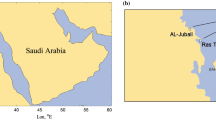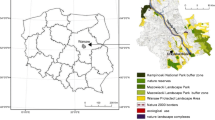Abstract
This article describes a new method for the analysis of fine (> 1 µm) atmospheric particulates using the Mineral Liberation Analyzer. After determining the optimum sampling technique, the accuracy and precision of the instrument were tested by repeat analysis and by comparison to certified reference materials, with relative standard deviations of less than 10% achieved. A pilot study using this method was applied to identify arsenic-bearing phases near a gold mine and to identify particulates near a large iron-ore mining operation. The results revealed the presence of only negligible amounts of the arsenic-bearing phases and sulfides typically associated with the gold deposit, with only 159 particles detected in the 22,511 particles analyzed. The presence of aluminum-enriched iron oxides in the particulates sampled near the iron-ore operation suggests that re-entrained soil is a significant source of particulates in this region. From the results of this study, the technique has been shown to have a significant potential for the rapid acquisition of reliable data for the characterization of airborne particulates, which is requisite for effective emissions management and for the monitoring of human and environmental health.





Similar content being viewed by others
References
Anonymous (2003) Elements by ICP, Method 7303. NIOSH Manual of Analytical Methods, Fourth Edition, Issue 1. Centers for Disease Control and Prevention, Atlanta, GA, USA. Retrieved 25 October, 2017, from www.cdc.gov/niosh/docs/2003-154/pdfs/7303.pdf
Anonymous (2014) AS/NZS 3580.9.15:2014. Methods for sampling and analysis of ambient air—determination of suspended particulate matter—particulate matter high or low volume sampler gravimetric collection—Inductively Coupled Plasma (ICP) spectrometric method. Standards Australia, Sydney, Australia
Balladares E, Kelm U, Helle S, Parra R, Araneda E (2014) Chemical-mineralogical characterization of copper smelting flue dust. Dyna 81(186):11–18
Burrows D, Gu Y (2006) JKMRC mineral liberation analyser—a modern tool for ore characterisation and plant optimisation. Proc Metall Plant Des Oper Strateg 2006:125–139
de Andrade Lima LRP, Bernardez LA (2017) Characterization of the soil contamination around the former primary lead smelter at Santo Amaro, Bahia, Brazil. Environ Earth Sci 76(14):470
de Carvalho Filho A, Inda AV, Fink JR, Curi N (2015) Iron oxides in soils of different lithological origins in Ferriferous Quadrilateral (Minas Gerais, Brazil). Appl Clay Sci 118:1–7
Diógenes Costa SÂ, Ker JC, Ferreira de Freitas Simões D, Ferreira Fontes MP, Domingos Fabris J, Vaz Andrade F (2014) Pedogênese e classificação de Latossolos desenvolvidos de itabiritos no Quadrilátero Ferrífero, MG. Revista Brasileira de Ciência do Solo. https://doi.org/10.1590/S0100-06832014000200001
Dobbe R, Gottlieb P, Gu Y, Butcher A, Fandrich R, Lemmens H (2009) Scanning electron beambased automated mineralogy-outline of technology and selected applications in the natural resources industry. In: European workshop on modern developments and applications in microbeam analysis: the book of tutorials and abstracts of EMAS 2009 11th European workshop on modern developments and applications in microbeam analysis
Elmes M, Gasparon M (2017) Sampling and single particle analysis for the chemical characterisation of fine atmospheric particulates: a review. J Environ Manag 202, Part 1:137–150
Fandrich R, Gu Y, Burrows D, Moeller K (2007) Modern SEM-based mineral liberation analysis. Int J Miner Process 84(1–4):310–320
Fang T, Guo H, Zeng L, Verma V, Nenes A, Weber RJ (2017) Highly acidic ambient particles, soluble metals, and oxidative potential: a link between sulfate and aerosol toxicity. Environ Sci Technol 51(5):2611–2620
FEI (2007) Mineral liberation analyzer. Retrieved 6/5, 2015, from http://www.microscop.ru/uploads/Oborudovanie/Analizatory/analizatory_materialov/HR_DS_MLA650.pdf
Gasparon M, Delbem I, Elmes M, Ciminelli V (2016) Detection and analysis of arsenic-bearing particles in atmospheric dust using Mineral Liberation Analysis. In: Arsenic research and global sustainability: proceedings of the sixth international congress on arsenic in the environment (As2016), June 19–23, 2016, Stockholm, Sweden. CRC Press
Goodall WR, Scales PJ (2007) An overview of the advantages and disadvantages of the determination of gold mineralogy by automated mineralogy. Miner Eng 20(5):506–517
Gu Y (2003) Automated scanning electron microscope based mineral liberation analysis. J Miner Mater Charact Eng 2(1):33–41
Gu Y, Napier-Munn T (1997) JK/Philips mineral liberation analyzer–an introduction. In: Proceedings of the minerals Processing’97 conference, Cape Town, SA
Hornby AJ, Lavallée Y, Kendrick JE, Rollinson G, Butcher AR, Clesham S, Kueppers U, Cimarelli C, Chigna G (2019) Phase partitioning during fragmentation revealed by QEMSCAN Particle Mineralogical Analysis of volcanic ash. Sci Rep 9(1):126
ICDD (2003) Powder diffraction file inorganic and organic data book. International Centre for Diffraction Data, Newtown Square
International Agency for Research on Cancer (2013, 17/10/2013). Outdoor air pollution a leading environmental cuse of cancer deaths. Retrieved 29/11, 2014, from http://www.iarc.fr/en/media-centre/iarcnews/pdf/pr221_E.pdf
Johnson C, Pownceby MI, Wilson NC (2015) The application of automated electron beam mapping techniques to the characterisation of low grade, fine-grained mineralisation; potential problems and recommendations. Miner Eng 79:68–83
Kelm U, Avendaño M, Balladares E, Helle S (2014) The use of water-extractable Cu, Mo, Zn, As, Pb concentrations and automated mineral analysis of flue dust particles as tools for impact studies in topsoils exposed to past emissions of a Cu-smelter. Chem Erde 74(3):365–373
Li J, Zhou L, Yan J, Cui X, Cai Y (2019) Source of aeolian dune sands on the northern margin of Qarhan Salt Lake, Qaidam Basin, NW China. Geol J. https://doi.org/10.1002/gj.3624
Martin TD, Creed JT, Brockhoff CA (1994) Method 200.2, revision 2.8: sample preparation procedure for spectrochemical determination of total recoverable elements. USEPA, Cincinnati
Martin R, Mather T, Pyle D, Power M, Tsanev V, Oppenheimer C, Allen A, Horwell C, Ward E (2009) Size distributions of fine silicate and other particles in Masaya’s volcanic plume. J Geophys Res Atmos. https://doi.org/10.1029/2008JD011211
McVicar MJ, Graves WJ (1997) The forensic comparison of soils by automated scanning electron microscopy. Can Soc Forensic Sci J 30(4):241–261
Morrison A, Nelson PF, Stelcer E, Cohen D, Haberlah D (2011) Quantifying respirable crystalline silica in the ambient air of the Hunter Valley, NSW—sorting the silica from the silicon. In: Proceedings of the 20th clean air & environment conference
Øxnevad S (2017) High-resolution heavy mineral studies on “black sands” from the Nama Group (Fish River Subgroup) in Namibia-Part I. University of Stavanger, Norway
Parbhakar-Fox A, Lottermoser B, Hartner R, Berry RF, Noble TL (2017) Prediction of acid rock drainage from automated mineralogy. In: Lottermoser B (ed) Environmental indicators in metal mining. Springer, Cham, pp 139–156. https://doi.org/10.1007/978-3-319-42731-7_8
Pirrie D, Rollinson GK (2011) Unlocking the applications of automated mineral analysis. Geol Today 27(6):226–235
Pirrie D, Butcher AR, Power MR, Gottlieb P, Miller GL (2004) Rapid quantitative mineral and phase analysis using automated scanning electron microscopy (QemSCAN); potential applications in forensic geoscience. Geol Soc Lond Spec Publ 232(1):123–136
Redwan M (2012) Application of mineral liberation analysis in studying micro-sedimentological structures within sulfide mine tailings and their effect on hardpan formation. Sci Total Environ 414:480–493
Redwan M, Rammlmair D, Nikonow W (2016) Application of quantitative mineralogy on the neutralization–acid potential calculations within µm-scale stratified mine tailings. Environ Earth Sci 76(1):46
Schraufnagel DE, Balmes JR, Cowl CT, De Matteis S, Jung S-H, Mortimer K, Perez-Padilla R, Rice MB, Riojas-Rodriguez H, Sood A, Thurston GD, To T, Vanker A, Wuebbles DJ (2019) Air pollution and noncommunicable diseases: a review by the forum of international respiratory societies’ environmental committee, part 1: the damaging effects of air pollution. Chest 155(2):409–416
Spier C, de Oliveira S, Rosière C, Ardisson J (2008) Mineralogy and trace-element geochemistry of the high-grade iron ores of the Águas Claras Mine and comparison with the Capão Xavier and Tamanduá iron ore deposits, Quadrilátero Ferrífero, Brazil. Miner Deposita 43(2):229–254
Stavinga D, Jamieson H, Layton-Matthews D, Paradis S, Falck H (2017) Geochemical and mineralogical controls on metal(loid) mobility in the oxide zone of the Prairie Creek Deposit, NWT. Geochem Explor Environ Anal 17(1):21–33
Stucki JW, Goodman BA, Schwertmann U (2012) Iron in soils and clay minerals. Springer, Berlin
Tang H-H, Sun W, Han H-S (2015) A novel method for comprehensive utilization of sintering dust. Trans Nonferrous Met Soc China 25(12):4192–4200
Tavares FVF, Ardisson JD, Rodrigues PCH, Fabris JD, Fernandez-Outon LE, Feliciano VMD (2017) Ferruginous compounds in the airborne particulate matter of the metropolitan area of Belo Horizonte, Minas Gerais, Brazil. Environ Sci Pollut Res 24(24):19683–19692
Tian Z, Dietze V, Sommer F, Baum A, Kaminski U, Sauer J, Maschowski C, Stille P, Cen K, Gieré R (2017) Coarse-particle passive-sampler measurements and single-particle analysis by transmitted light microscopy at highly frequented motorways. Aerosol Air Qual Res 17(8):1939
Tonzetic I, Butcher A, Cropp AF, Pudmenzky C (2006) Automated SEM analysis (measurement & characterisation) of dust using QEMSCAN
Tsikouras B, Pe-Piper G, Piper DJ, Schaffer M (2011) Varietal heavy mineral analysis of sediment provenance, Lower Cretaceous Scotian Basin, eastern Canada. Sed Geol 237(3–4):150–165
VDI (2013) Ambient air measurements sampling of atmospheric particles > 2.5 µm on an acceptor surface using the Sigma-2 passive sampler. Characterization by optical microscopy and calculation of number settling rate and mass concentration. ICS: 13.040.01. Beuth Verlag, Berlin
Williamson BJ, Rollinson G, Pirrie D (2013) Automated mineralogical analysis of PM10: new parameters for assessing PM toxicity. Environ Sci Technol 47(11):5570–5577
Acknowledgements
The authors declare that they have no known competing financial interests or personal relationships that could have appeared to influence the work reported in this paper. The authors acknowledge the financial support from the Brazilian agencies, Conselho Nacional de DesenvolvimentoCientífico e Tecnológico—CNPq—and Fundação do Amparo a Pesquisa do Estado de Minas Gerais-FAPEMIG—INCT-Acqua PROCESS No: 573945/2008-0, including a PVE Fellowship from the Science Without Borders program to M. Gasparon. This study was financed in part by the Coordenação de Aperfeiçoamento de Pessoal de Nível Superior—Brasil (CAPES)—Finance Code 00. The Centre of Microscopy at the Universidade Federal de Minas Gerais (UFMG) provided the equipment and support for all MLA analyses.
Author information
Authors and Affiliations
Corresponding author
Additional information
Editorial responsibility: M. Abbaspour.
Electronic supplementary material
Below is the link to the electronic supplementary material.
Rights and permissions
About this article
Cite this article
Elmes, M., Delbem, I., Gasparon, M. et al. Single-particle analysis of atmospheric particulate matter using automated mineralogy: the potential for monitoring mine-derived emissions. Int. J. Environ. Sci. Technol. 17, 2743–2754 (2020). https://doi.org/10.1007/s13762-020-02660-w
Received:
Revised:
Accepted:
Published:
Issue Date:
DOI: https://doi.org/10.1007/s13762-020-02660-w




